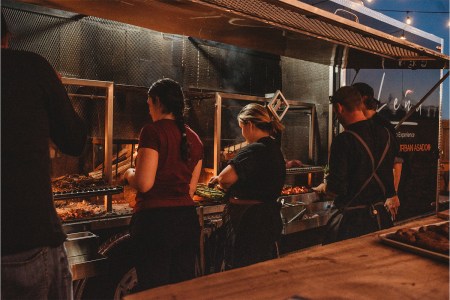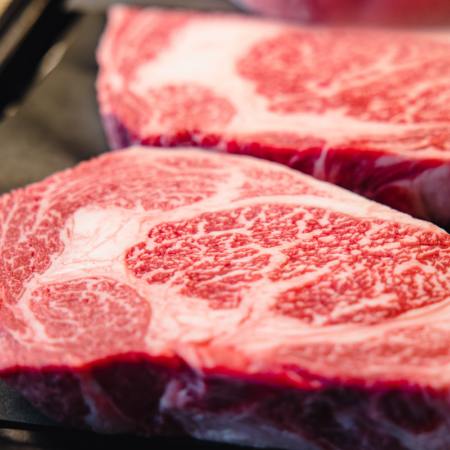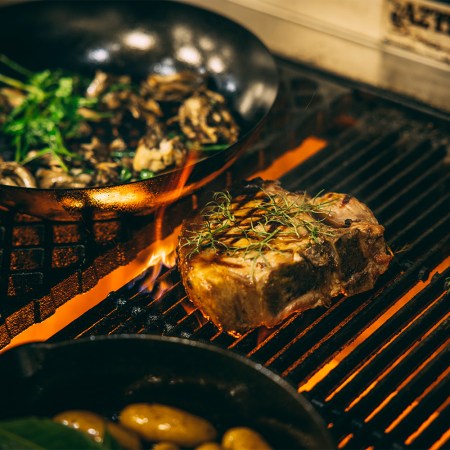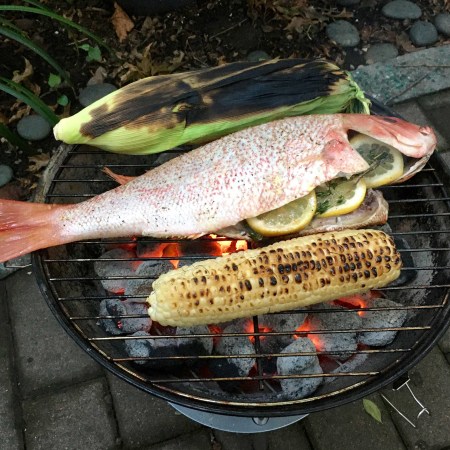Any grillmaster worth their salt has long moved past mere burgers and dogs. But this summer, we’re pushing the envelope even more thanks to advice from chef Matt Moore, author of the brand-new Butcher on the Block: Everyday Recipes, Stories, and Inspirations from Your Local Butcher. The aficionado of all things meat has noticed quite a few new grilling trends and developments on the scene. Chief among them? Close attention to sourcing.
It’s not news that meat production has outsized effects on the environment, accounting for nearly a third of all greenhouse gas emissions. And murky humane standards — while certainly improved by labels like the organic certification or, even better, Animal Welfare Approved — certainly don’t inspire confidence. For that, Moore turns to local butchers.
“The local butcher is your conduit to great food, an expert in knowledge and likely also a champion of the community, too,” he says. “My entire goal of writing Butcher on the Block was to expose the audience to the friendship and trust that comes with getting to know the folks who work behind the counter – from the local shop to the supermarket.”
Once you’ve got your hands on the goods, here are the grilling trends Moore says will help you take full advantage of top-notch meats this season.
At-Home Dry-Aged Beef
It’s time to pull back the curtain on dry-aging. This method is essentially a means of controlled rotting, but don’t let that deter you: dry-aged beef is deeper, richer and more complex. And while it’s certainly pricier, it’s well worth the extra cost for Moore.
“I think one of the items that’s most prized at the local butcher is their approach to dry aging,” he says. “Typically, they will be able to source the larger cuts that take well to this process and, with their level of expertise, they can age product from 15 to 75 days and beyond for reliable results. Dry aging is a big reason folks prefer to shop at a local butcher, as opposed to a supermarket where most meats are wet aged.”
In his new book, Moore offers a DIY approach to this technique, no longer relegated to the pros. Dry-aging bags allow you to use the safety of your fridge to cultivate a quality result at a fraction of the price. Of course, a dry-aging bag has nothing on the sort of aging room most professionals have at their disposal. But for Moore, “It’s a ‘primer’ to the art that I thought was worth mentioning for those curious or seeking to advance their grilling repertoire.”
Embracing Offal
The American market hasn’t always been the friendliest towards the organ meats that are commonplace elsewhere in the world. But whole-animal butchery is the far more sustainable approach to eating meat, and thanks to pioneering restaurants that have familiarized diners with everything from liver to oxtail, Moore thinks we’re ready to bring these cuts home.
“At the end of the day, it’s all about exposure,” he says. “So, while some folks might have their first taste of a beef heart tartare at a restaurant, they might be more willing to do a beef or duck heart kebab at home because the stigma has been removed.”
One of his favorite ways to put this trend on the grill is with a sweetbreads recipe from Rihm Foods. This dish sees thymus gland (or more rarely, pancreas) griddled in a cast-iron pan on the grill before being steamed with beer. It’s a good jumping-off point for home cooks, not just because it has a luscious texture and milder flavor compared to liver or kidneys, but also because they’re fairly idiot-proof.
“The beautiful thing about this cut is you really can’t overcook them,” he says. “So it’s a good starting point for home cooks.”
Grillmasters, You Need to See These Tremendous, Florida-Made, Argentine-Style Grills
Or just grab a bite at the weekly Leña Asado dining series — your callPlanking (Yep, It’s Back)
Cooking fish on a plank of cedar wood was all the rage in the ‘90s. And much like combat boots and pinstripes, planking is back and better than ever.
“I think planking, especially for seafood, is a great option for home cooks and grillers who often might worry about cooking seafood (especially losing most of it to the fire of the grill!),” he says. For Moore, the plank isn’t just beneficial in keeping small or delicate items from slipping into the coals — it also imparts flavor to both proteins and vegetables.
“Soaking the planks in water prior to cooking and placing over indirect heat are really my two tips to ensure success,” he adds.
More Plants
Fifteen years ago, plant-based diners at a backyard barbecue would be hard-pressed to find anything tastier than a sad soy patty on offer. But as the food world embraces more and more plants, the grill is becoming ever-more vegan friendly. Moore’s book notably includes a recipe for the now-omnipresent corn ribs, which he’s particularly fond of for kids.
“As a father of two girls, it’s a necessity,” he says. “Think about it — how many times does a whole ear of corn go to waste because the kiddo just eats a few bites? Cutting the ears into ribs not only exposes more surface area to create crispy charred edges, but it also ensures nothing goes to waste.”
Corn ribs aren’t the only veggies he’s throwing on the grill. That jack-of-all-plant-based-trades cauliflower has been contorted into all forms from rice to mash to steak, but Moore is reevaluating the latter with a different crucifer. “I upped the ante with a cabbage steak in this particular book,” he says. “The cabbage takes on plenty of char and smoke, and spiked with some tangy feta, it’s a plant-based option that will satisfy any carnivore.”
Pink Pork
When the pork lobby positioned swine as “the other white meat,” they did it an unfortunate ding. Pork does indeed need to be cooked until it’s nearly white in the center to stave off health risks if the risk of trichinosis contamination is high. But streamlined supply chains and increased USDA inspections mean the risk is negligible in the United States. According to Moore, top-quality pork can safely be cooked to an internal temp of 135º to 140º Fahrenheit, rendering it tender, juicy and pink.
“As someone who has a revolving door of folks coming over for dinner, a pork tenderloin is often my go-to for entertaining because it’s a tender, affordable cut that’s a blank canvas for an array of marinades, sauces and salsas,” he says. And pork, he adds, is “my go-to at any steakhouse willing to feature a pork chop over a steak.”
Every Thursday, our resident experts see to it that you’re up to date on the latest from the world of drinks. Trend reports, bottle reviews, cocktail recipes and more. Sign up for THE SPILL now.
























